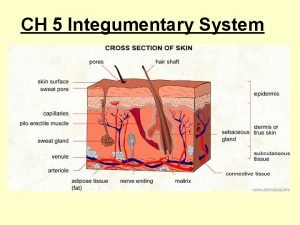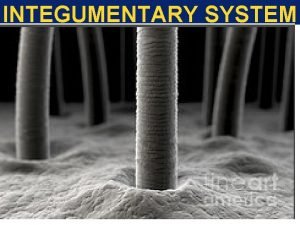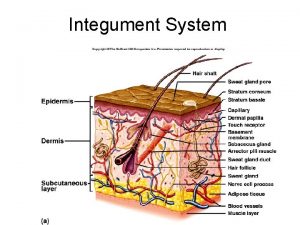The Integumentary System The Integumentary System Integument is


















- Slides: 18

The Integumentary System

The Integumentary System Integument is skin n Skin and its appendages make up the integumentary system n A fatty layer (hypodermis) lies deep to it n Two distinct regions n ¨ Epidermis ¨ Dermis

Functions of skin n Protection ¨ Cushions and insulates and is waterproof ¨ Protects from chemicals, heat, cold, bacteria ¨ Screens UV n n Synthesizes vitamin D with UV Regulates body heat Prevents unnecessary water loss Sensory reception (nerve endings)

Remember… n Three basic types of tissue ¨Connective tissue - dermis ¨Muscle tissue ¨Nervous tissue

Epidermis n Layers (from deep to superficial) ¨ Stratum basale or germinativum – single row of cells attached to dermis; youngest cells ¨ Stratum spinosum – spinyness is artifactual; tonofilaments (bundles of protein) resist tension ¨ Stratum granulosum – layers of flattened keratinocytes producing keratin (hair and nails made of it also) ¨ Stratum lucidum (only on palms and soles) ¨ Stratum corneum – horny layer (cells dead, many layers thick)

Dermis n Strong, flexible connective tissue: your “hide” n Rich supply of nerves and vessels n Critical role in temperature regulation (the vessels)

*Dermis layers *Dermal papillae * *

Hypodermis “Hypodermis” (Gk) = below the skin n “Subcutaneous” (Latin) = below the skin n Also called “superficial fascia” n “fascia” (Latin) =band; in anatomy: sheet of connective tissue Fatty tissue which stores fat and anchors skin (areolar tissue and adipose cells) n Different patterns of accumulation (male/female) n

Skin color n Three skin pigments ¨ Melanin: the most important ¨ Carotene: from carrots and yellow vegies ¨ Hemoglobin: the pink of light skin n Melanin in granules passes from melanocytes (same number in all races) to keratinocytes in stratum basale

Skin appendages Derived from epidermis but extend into dermis n Include n ¨ Hair and hair follicles ¨ Sebaceous (oil) glands ¨ Sweat (sudoiferous) glands ¨ Nails


Nails Of hard keratin n Grows from nail matrix n

Hair and hair follicles: complex Functions of hair Warmth – less in man than other mammals Sense light touch of the skin Protection - scalp

Sebaceous (oil) glands n n n Entire body except palms and soles Produce sebum by holocrine secretion Oils and lubricates

Sweat glands n n n Entire skin surface except nipples and part of external genitalia Prevent overheating 500 cc to 12 l/day! (is mostly water) Humans most efficient (only mammals have) Produced in response to stress as well as heat

Disorders of the integumentary system n Burns ¨ Threat to life n Catastrophic loss of body fluids n Dehydration and fatal circulatory shock n Infection ¨ Types n First degree – epidermis: redness (e. g. sunburn) n Second degree – epidermis and upper dermis: blister n Third degree - full thickness

Burns First-degree (epidermis only; redness) Second-degree (epidermis and dermis, with blistering) Third-degree (full thickness, destroying epidermis, often part of hypodermis)

Critical burns n n n Over 10% of the body has thirddegree burns 25 % of the body has seconddegree burns Third-degree burns on face, hands, or feet Estimate by “rule of 9’s”
 Stratum basale
Stratum basale Integumentary system adalah
Integumentary system adalah Integument
Integument Integument
Integument Integumentary
Integumentary Dr asam
Dr asam Bio 211
Bio 211 Glands in integumentary system
Glands in integumentary system Integumentary system vocabulary
Integumentary system vocabulary Integumentary system pig
Integumentary system pig The integumentary system facts
The integumentary system facts The integumentary system exercise 7
The integumentary system exercise 7 Integumentary vocabulary
Integumentary vocabulary Integumentary system
Integumentary system Integumentary system physical examination
Integumentary system physical examination Excretory system analogy
Excretory system analogy Cat integumentary system
Cat integumentary system The integumentary system
The integumentary system Figure 5-1 the components of the integumentary system
Figure 5-1 the components of the integumentary system

































